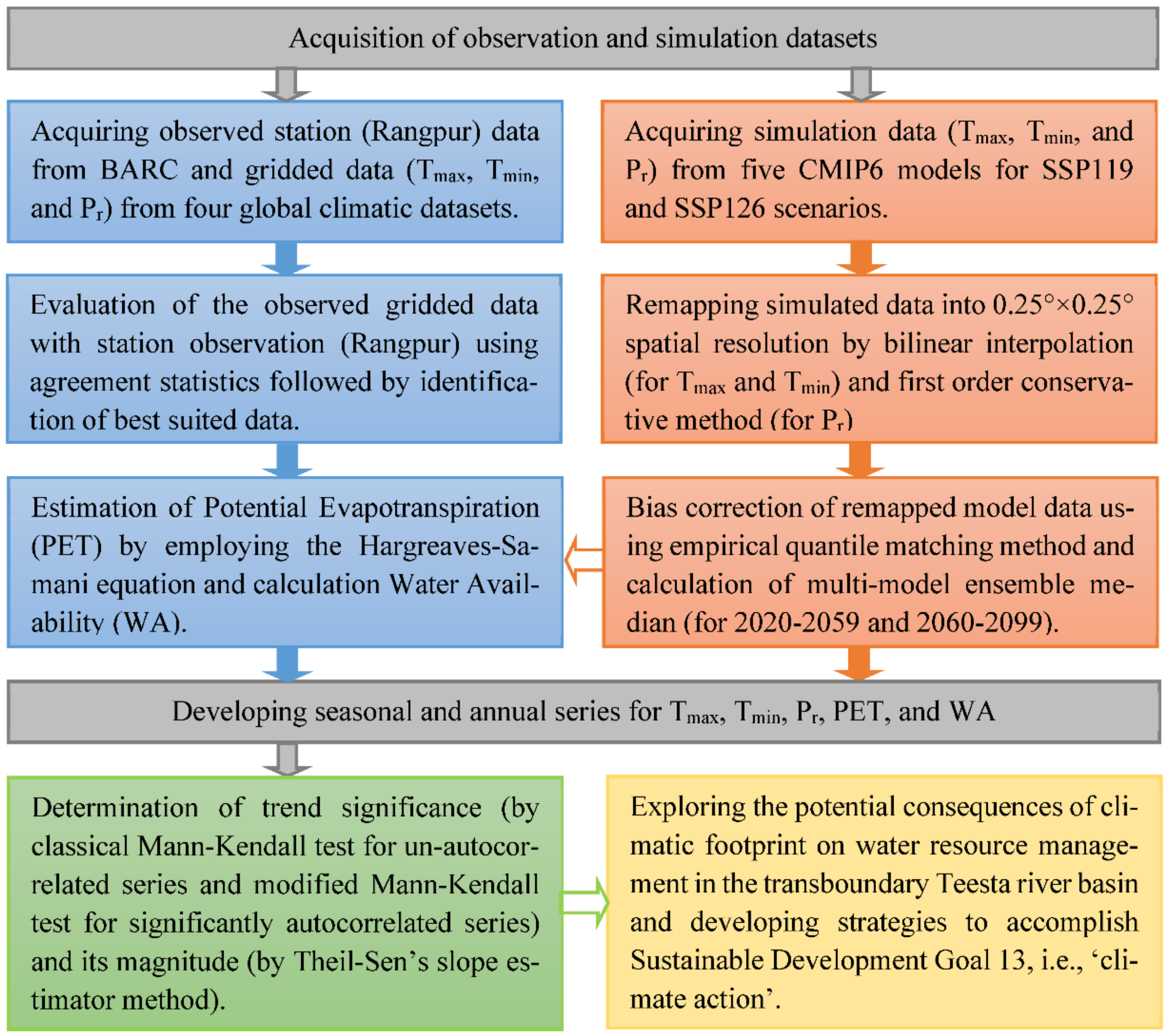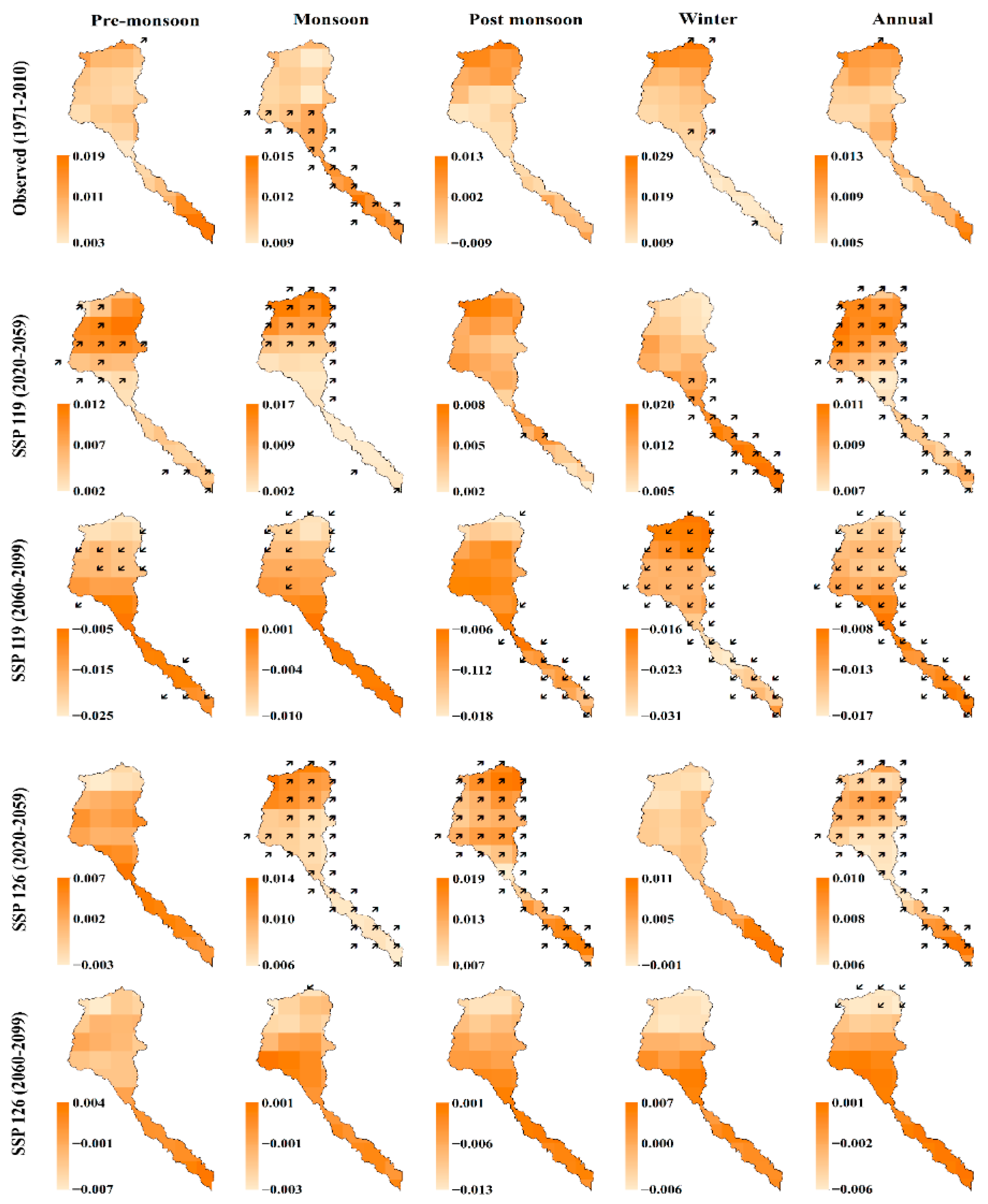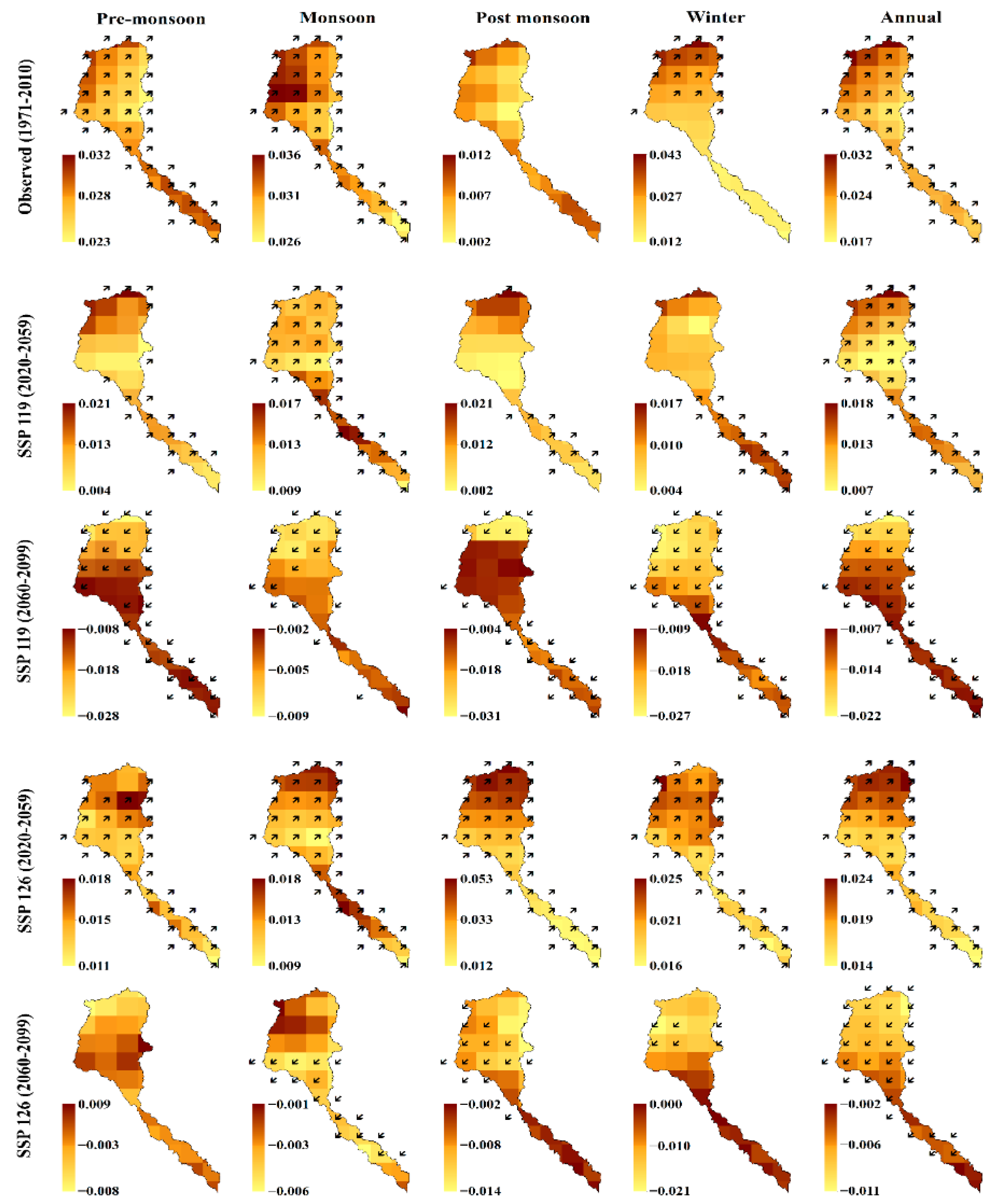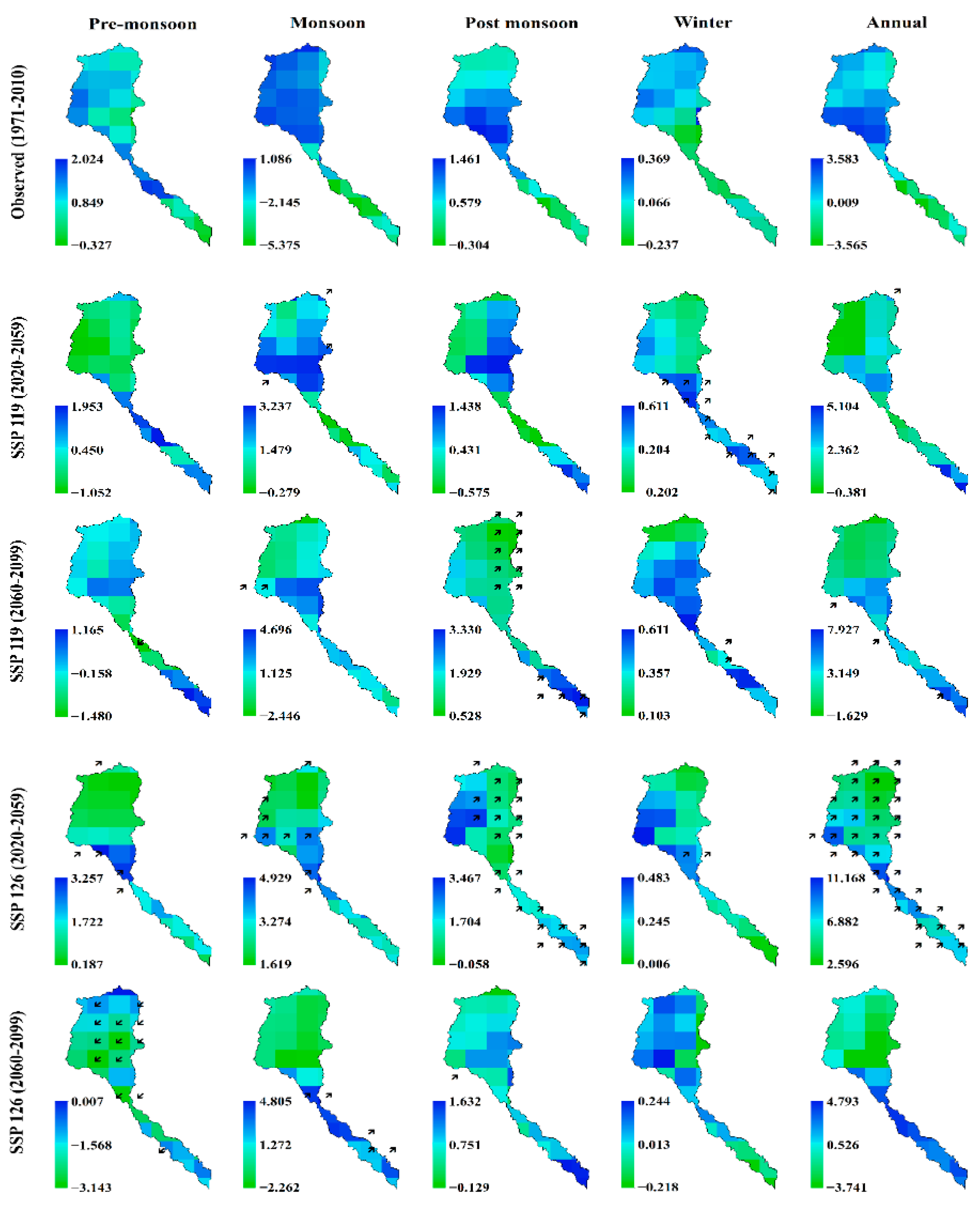Trends in Temperature, Precipitation, Potential Evapotranspiration, and Water Availability across the Teesta River Basin under 1.5 and 2 °C Temperature Rise Scenarios of CMIP6
Abstract
:1. Introduction
2. Background of the Study Area
3. Materials and Methods
3.1. Data Type and Source
3.1.1. Observational Data
3.1.2. Simulation Data
| Observation Data | Source Institution | Spatial Resolution | Reference | |
|---|---|---|---|---|
| Station | Rangpur | Bangladesh Agricultural Research Council (BARC) | — | [35] |
| Gridded | CRU TS v4.05 | University of East Anglia, UK | 0.5° × 0.5° | [36] |
| PGF | Princeton University, New Jersey | 0.25° × 0.25° | [37] | |
| ERA5 | European Centre for Medium-Range Weather Forecasts, UK | 0.25° × 0.25° | [38] | |
| IMDAA | A collaborative effort among the Met Office, UK, the National Centre for Medium Range Weather Forecasting, India and the India Meteorological Department | 0.12° × 0.12° | [30] | |
| CMIP6 Model | Modeling Center | Spatial Resolution | Reference | |
| Simulation | CanESM5 | Canadian Centre for Climate Modelling and Analysis, Canada | 2.8° × 2.8° | [39] |
| GFDL-ESM4 | Geophysical Fluid Dynamics Laboratory, National Oceanic and Atmospheric Administration, USA | 1.3° × 1° | [40] | |
| IPSL-CM6A-LR | Institut Pierre-Simon Laplace, Sorbonne Université, France | 2.5° × 1.3° | [41] | |
| MIROC6 | Atmosphere and Ocean Research Institute, The University of Tokyo, Japan | 1.4° × 1.4° | [42] | |
| MRI-ESM2-0 | The Meteorological Research Institute, Japan | 2.8° × 2.8° | [43] | |
3.2. Methodology
3.2.1. Performance Evaluation
Pearson Correlation Coefficient (R)
Coefficient of Determination (R2)
Normalized Root Mean Squared Error (nRMSE)
Mean Bias Error (MBE)
Index of Agreement (IOA)
3.2.2. Bias Correction of the GCM Outputs
3.2.3. Estimation of Potential Evapotranspiration (PET)
3.2.4. Calculation of Water Availability (WA)
3.2.5. Detection of Trend and its Magnitude
The Mann–Kendall (MK) test
Theil–Sen slope estimator (TSSE)
Modified Mann–Kendall (MMK) test
4. Results
4.1. Performance Evaluation of the Gridded Observation Data
4.2. Performance of the Bias-Corrected CMIP6 Model Data
4.3. Trends and Trend Magnitudes in Temperature (Tmax and Tmin)
4.4. Trends and Trend Magnitudes in the Precipitation
4.5. Trends and Trend Magnitudes in the Potential Evapotranspiration (PET)
4.6. Trends and Trend Magnitudes in the Water Availability (WA)
5. Discussion
6. Conclusions and Way Forward
- For a long-term solution, both the riparian countries should reinitiate the dialogue process of the Joint River Commission (JRC, a bilateral working group established by India and Bangladesh in 1972 for the Indo-Bangla Treaty of Friendship, Cooperation and Peace) to avoid water disputes and strengthen the mutual cooperation for controlling floods and tackling the water crisis. Apart from this, both nations could build reservoirs over the river basin to store the excess monsoonal rainfall and connect them with the existing canal network to meet the irrigational demands, especially during the lean period.
- For immediate or short-term actions, both the countries might follow optimal water use and conservation (like rainwater harvesting) through community-driven participatory management and discourage the wet variety of Boro paddy cultivation by encouraging drought-tolerant cash crops. Having said that, if the total volume of irrigable water is utilized for the other winter crops instead of Boro, then at most, 45,000 ha of land could be irrigated [21].
- Excavation of deep farm ponds is also an alternative and economical path not only to store rainwater but also meaningful to mitigate sudden floods. At the same time, it is capable of replenishing groundwater and soil moisture levels.
Supplementary Materials
Author Contributions
Funding
Institutional Review Board Statement
Informed Consent Statement
Data Availability Statement
Acknowledgments
Conflicts of Interest
References
- Melesse, A.M.; Abtew, W.; Setegn, S.G. (Eds.) Nile River Basin: Ecohydrological Challenges, Climate Change and Hydropolitics; Springer International Publishing: Cham, Switzerland, 2014. [Google Scholar]
- Mahmood, R.; Jia, S. Assessment of impacts of climate change on the water resources of the transboundary Jhelum River basin of Pakistan and India. Water 2016, 8, 246. [Google Scholar] [CrossRef] [Green Version]
- Barnes, J. The future of the Nile: Climate change, land use, infrastructure management, and treaty negotiations in a transboundary river basin. Wiley Interdiscip. Rev. Clim. Change 2017, 8, 449. [Google Scholar] [CrossRef]
- Shamir, E.; Tapia-Villaseñor, E.M.; Cruz-Ayala, M.B.; Megdal, S.B. A review of climate change impacts on the USA-Mexico transboundary Santa Cruz River Basin. Water 2021, 13, 1390. [Google Scholar] [CrossRef]
- Soroush, F.; Fathian, F.; Khabisi, F.S.H.; Kahya, E. Trends in pan evaporation and climate variables in Iran. Theor. Appl. Climatol. 2020, 142, 407–432. [Google Scholar] [CrossRef]
- Qin, M.; Zhang, Y.; Wan, S.; Yue, Y.; Cheng, Y.; Zhang, B. Impact of climate change on “evaporation paradox” in province of Jiangsu in southeastern China. PLoS ONE 2021, 16, 0247278. [Google Scholar] [CrossRef]
- Goyal, M.K.; Goswami, U.P. Teesta river and its ecosystem. In The Indian Rivers; Springer: Singapore, 2018; pp. 537–551. [Google Scholar]
- Prasai, S.; Surie, M.D. Transboundary Water Cooperation Key to Easing South Asia’s Water Woes. The Asia Foundation. 20 March 2013. Available online: https://asiafoundation.org/2013/03/20/transboundary-water-cooperation-key-to-easing-south-asias-water-woes/ (accessed on 26 June 2021).
- Gambhir, M. Teesta Dispute and India-Bangladesh Relations. 2021. Available online: https://www.claws.in/teesta-dispute-and-india-bangladesh-relations/#_edn6 (accessed on 22 July 2021).
- Farinosi, F.; Giupponi, C.; Reynaud, A.; Ceccherini, G.; Carmona-Moreno, C.; De Roo, A.; Gonzalez-Sanchez, D.; Bidoglio, G. An innovative approach to the assessment of hydro-political risk: A spatially explicit, data driven indicator of hydro-political issues. Glob. Environ. Change 2018, 52, 286–313. [Google Scholar] [CrossRef]
- Islam, M.F. Water Use and Poverty Reduction; Springer: Tokyo, Japan, 2016. [Google Scholar]
- Arfanuzzaman, M.; Syed, M.A. Water demand and ecosystem nexus in the transboundary river basin: A zero-sum game. Environ. Dev. Sustain. 2018, 20, 963–974. [Google Scholar] [CrossRef]
- United Nations. UN Convention on the Law of Non-Navigational Uses of International Watercourses. 1997. Available online: https://legal.un.org/ilc/texts/instruments/english/conventions/8_3_1997.pdf (accessed on 5 April 2020).
- Soorya, S.; Adarsh, S.; Priya, K.L. Trend analysis of rainfall projections of Teesta river basin, Sikkim using non-parametric tests and ensemble empirical mode decomposition. In Emerging Trends in Engineering, Science and Technology for Society, Energy and Environment; Vanchipura, R., Jiji, K.S., Eds.; CRC Press: Boca Raton, FL, USA, 2018; pp. 103–110. [Google Scholar]
- Sharma, A.; Goyal, M.K. Assessment of the changes in precipitation and temperature in Teesta River basin in Indian Himalayan Region under climate change. Atmos. Res. 2020, 231, 104670. [Google Scholar] [CrossRef]
- Kumar, D.; Arya, D.S.; Murumkar, A.R.; Rahman, M.M. Impact of climate change on rainfall in Northwestern Bangladesh using multi-GCM ensembles. Int. J. Climatol. 2014, 34, 1395–1404. [Google Scholar] [CrossRef]
- Su, B.; Huang, J.; Mondal, S.K.; Zhai, J.; Wang, Y.; Wen, S.; Gao, M.; Lv, Y.; Jiang, S.; Jiang, T.; et al. Insight from CMIP6 SSP-RCP scenarios for future drought characteristics in China. Atmos. Res. 2021, 250, 105375. [Google Scholar] [CrossRef]
- Noolkar-Oak, G. Geopolitics of Water Conflicts in the Teesta River Basin. 2017. Available online: https://www.indiawaterportal.org/sites/indiawaterportal.org/files/geopolitics_of_water_conflicts_in_the_teesta_river_basin_gauri_noolkar_oak_2018.pdf (accessed on 16 March 2019).
- Peel, M.C.; Finlayson, B.L.; McMahon, T.A. Updated world map of the Köppen-Geiger climate classification. Hydrol. Earth Syst. Sci. 2007, 11, 1633–1644. [Google Scholar] [CrossRef] [Green Version]
- Bangladesh Bureau of Statistics (BBS). Bangladesh Data Sheet. 2011. Available online: http://www.bbs.gov.bd/WebTestApplication/userfiles/Image/SubjectMatterDataIndex/datasheet.xls (accessed on 17 August 2016).
- Rudra, K. Sharing water across Indo-Bangladesh border. In Regional Cooperation in South Asia: Socio-Economic, Spatial, Ecological and Institutional Aspects (Contemporary South Asian Studies); Bandyopadhyay, S., Torre, A., Casaca, P., Dentinho, T., Eds.; Springer: Cham, Switzerland, 2017; pp. 189–207. [Google Scholar]
- Datta, P.; Das, S. Analysis of long-term seasonal and annual temperature trends in North Bengal, India. Spat. Inf. Res. 2019, 27, 475–496. [Google Scholar] [CrossRef]
- Nalley, D.; Adamowski, J.; Khalil, B.; Ozga-Zielinski, B. Trend detection in surface air temperature in Ontario and Quebec, Canada during 1967–2006 using the discrete wavelet transform. Atmos. Res. 2013, 132, 375–398. [Google Scholar] [CrossRef]
- Datta, P.; Das, S. Analysis of long-term precipitation changes in West Bengal, India: An approach to detect monotonic trends influenced by autocorrelations. Dyn. Atmos. Ocean. 2019, 88, 101118. [Google Scholar] [CrossRef]
- Singh, J.; Sahany, S.; Robock, A. Can stratospheric geoengineering alleviate global warming-induced changes in deciduous fruit cultivation? The case of Himachal Pradesh (India). Clim. Change 2020, 162, 1323–1343. [Google Scholar] [CrossRef]
- Sedova, B.; Kalkuhl, M. Who are the climate migrants and where do they go? Evidence from rural India. World Dev. 2020, 129, 104848. [Google Scholar] [CrossRef]
- Robertson, A.W.; Bell, M.; Cousin, R.; Curtis, A.; Li, S. Online Tools for Assessing the Climatology and Predictability of Rainfall and Temperature in the Indo-Gangetic Plains Based on Observed Datasets and Seasonal Forecast Models; CCAFS Working Papers; CGIAR: Montpellier, France, 2013. [Google Scholar]
- Aslam, R.A.; Shrestha, S.; Pal, I.; Ninsawat, S.; Shanmugam, M.S.; Anwar, S. Projections of climatic extremes in a data poor transboundary river basin of India and Pakistan. Int. J. Climatol. 2020, 40, 4992–5010. [Google Scholar] [CrossRef]
- Aadhar, S.; Mishra, V. On the occurrence of the worst drought in South Asia in the observed and future climate. Environ. Res. Lett. 2021, 16, 024050. [Google Scholar] [CrossRef]
- Rani, S.I.; Arulalan, T.; George, J.P.; Rajagopal, E.N.; Renshaw, R.; Maycock, A.; Barker, D.M.; Rajeevan, M. IMDAA: High-Resolution Satellite-Era Reanalysis for the Indian Monsoon Region. J. Clim. 2021, 34, 5109–5133. [Google Scholar] [CrossRef]
- Almazroui, M.; Saeed, S.; Saeed, F.; Islam, M.N.; Ismail, M. Projections of precipitation and temperature over the South Asian countries in CMIP6. Earth Syst. Environ. 2020, 4, 297–320. [Google Scholar] [CrossRef]
- Karim, R.; Tan, G.; Ayugi, B.; Babaousmail, H.; Liu, F. Evaluation of historical CMIP6 model simulations of seasonal mean temperature over Pakistan during 1970–2014. Atmosphere 2020, 11, 1005. [Google Scholar] [CrossRef]
- Kamal, A.S.M.; Hossain, F.; Shahid, S. Spatiotemporal changes in rainfall and droughts of Bangladesh for 1.5 and 2 °C temperature rise scenarios of CMIP6 models. Theor. Appl. Climatol. 2021, 146, 527–542. [Google Scholar] [CrossRef]
- Eyring, V.; Bony, S.; Meehl, G.A.; Senior, C.A.; Stevens, B.; Stouffer, R.J.; Taylor, K.E. Overview of the Coupled Model Intercomparison Project Phase 6 (CMIP6) experimental design and organization. Geosci. Model Dev. 2016, 9, 1937–1958. [Google Scholar] [CrossRef] [Green Version]
- Bangladesh Agricultural Research Council. Climate Information Management System. Available online: http://www.barc.gov.bd/ (accessed on 17 January 2022).
- Harris, I.; Osborn, T.J.; Jones, P.; Lister, D. Version 4 of the CRU TS monthly high-resolution gridded multivariate climate dataset. Sci. Data 2020, 7, 109. [Google Scholar] [CrossRef] [Green Version]
- Sheffield, J.; Goteti, G.; Wood, E.F. Development of a 50-year high-resolution global dataset of meteorological forcings for land surface modeling. J. Clim. 2006, 19, 3088–3111. [Google Scholar] [CrossRef] [Green Version]
- Hersbach, H.; Bell, B.; Berrisford, P.; Hirahara, S.; Horányi, A.; Muñoz-Sabater, J.; Nicolas, J.; Peubey, C.; Radu, R.; Schepers, D.; et al. The ERA5 global reanalysis. Q. J. R. Meteorol. Soc. 2020, 146, 1999–2049. [Google Scholar] [CrossRef]
- Swart, N.C.; Cole, J.N.; Kharin, V.V.; Lazare, M.; Scinocca, J.F.; Gillett, N.P.; Anstey, J.; Arora, V.; Christian, J.R.; Hanna, S.; et al. The Canadian earth system model version 5 (CanESM5. 0.3). Geosci. Model Dev. 2019, 12, 4823–4873. [Google Scholar] [CrossRef] [Green Version]
- Held, I.M.; Guo, H.; Adcroft, A.; Dunne, J.P.; Horowitz, L.W.; Krasting, J.; Shevliakova, E.; Winton, M.; Zhao, M.; Bushuk, M.; et al. Structure and performance of GFDL’s CM4. 0 climate model. J. Adv. Modeling Earth Syst. 2019, 11, 3691–3727. [Google Scholar] [CrossRef] [Green Version]
- Boucher, O.; Servonnat, J.; Albright, A.L.; Aumont, O.; Balkanski, Y.; Bastrikov, V.; Bekki, S.; Bonnet, R.; Bony, S.; Bopp, L.; et al. Presentation and evaluation of the IPSL-CM6A-LR climate model. J. Adv. Modeling Earth Syst. 2020, 12, e2019MS002010. [Google Scholar] [CrossRef]
- Tatebe, H.; Ogura, T.; Nitta, T.; Komuro, Y.; Ogochi, K.; Takemura, T.; Sudo, K.; Sekiguchi, M.; Abe, M.; Saito, F.; et al. Description and basic evaluation of simulated mean state, internal variability, and climate sensitivity in MIROC6. Geosci. Model Dev. 2019, 12, 2727–2765. [Google Scholar] [CrossRef] [Green Version]
- Yukimoto, S.; Kawai, H.; Koshiro, T.; Oshima, N.; Yoshida, K.; Urakawa, S.; Tsujino, H.; Deushi, M.; Tanaka, T.; Hosaka, M.; et al. The Meteorological Research Institute Earth System Model version 2.0, MRI-ESM2. 0: Description and basic evaluation of the physical component. J. Meteorol. Soc. Japan Ser. II 2019, 97, 931–965. [Google Scholar] [CrossRef] [Green Version]
- Kanda, N.; Negi, H.S.; Rishi, M.S.; Kumar, A. Performance of various gridded temperature and precipitation datasets over Northwest Himalayan Region. Environ. Res. Commun. 2020, 2, 085002. [Google Scholar] [CrossRef]
- Rezaei, M.; Azhdary Moghaddam, M.; Azizyan, G.; Shamsipur, A.A. Assessment of precipitation obtained from gridded data bases in southern Baluchestan basin. Environ. Water Eng. 2022. [Google Scholar] [CrossRef]
- Salman, S.A.; Shahid, S.; Ismail, T.; Al-Abadi, A.M.; Wang, X.J.; Chung, E.S. Selection of gridded precipitation data for Iraq using compromise program-ming. Measurement 2019, 132, 87–98. [Google Scholar] [CrossRef]
- Ahmed, K.; Shahid, S.; Ali, R.O.; Bin Harun, S.; Wang, X.J. Evaluation of the performance of gridded precipitation products over Balochistan Province, Pakistan. Desalin. Water Treat. 2017, 79, 73–86. [Google Scholar] [CrossRef]
- Willmott, C.J. On the validation of models. Phys. Geogr. 1981, 2, 184–194. [Google Scholar] [CrossRef]
- Mishra, V.; Bhatia, U.; Tiwari, A.D. Bias-corrected climate projections for South asia from coupled model intercomparison project-6. Sci. Data 2020, 7, 338. [Google Scholar] [CrossRef]
- Jones, P.W. First- and second-order conservative remapping schemes for grids in spherical coordinates. Mon. Weather Rev. 1999, 127, 2204–2210. [Google Scholar] [CrossRef]
- Saeed, S.; Brisson, E.; Demuzere, M.; Tabari, H.; Willems, P.; van Lipzig, N.P. Multidecadal convection permitting climate simulations over Belgium: Sensitivity of future precipitation extremes. Atmos. Sci. Lett. 2017, 18, 29–36. [Google Scholar] [CrossRef] [Green Version]
- Gudmundsson, L.; Bremnes, J.B.; Haugen, J.E.; Engen-Skaugen, T. Downscaling RCM precipitation to the station scale using statistical transformations—A comparison of methods. Hydrol. Earth Syst. Sci. 2012, 16, 3383–3390. [Google Scholar] [CrossRef] [Green Version]
- Boé, J.; Terray, L.; Habets, F.; Martin, E. Statistical and dynamical downscaling of the Seine basin climate for hydro-meteorological studies. Int. J. Climatol. 2007, 27, 1643–1655. [Google Scholar] [CrossRef]
- Themeßl, M.; Gobiet, A. Empirical-statistical downscaling and model error correction of daily temperature and precipitation from regional climate simulations and the effects on climate change signals. In Proceedings of the EGU General Assembly, Vienna, Austria, 2–7 May 2010; Volume 12, p. 9664. [Google Scholar]
- Wetterhall, F.; Pappenberger, F.; He, Y.; Freer, J.; Cloke, H.L. Conditioning model output statistics of regional climate model precipitation on circulation patterns. Nonlinear Process. Geophys. 2012, 19, 623–633. [Google Scholar] [CrossRef] [Green Version]
- Shahidian, S.; Serralheiro, R.; Serrano, J.; Teixeira, J.; Haie, N.; Santos, F. Hargreaves and Other Reduced-Set Methods for Calculating Evapotranspiration; IntechOpen: London, UK, 2012; pp. 59–80. [Google Scholar]
- Rajabi, A.; Babakhani, Z. The study of potential evapotranspiration in future periods due to climate change in west of Iran. Int. J. Clim. Change Strateg. Manag. 2018, 10, 161–177. [Google Scholar] [CrossRef]
- Droogers, P.; Allen, R.G. Estimating reference evapotranspiration under inaccurate data conditions. Irrig. Drain. Syst. 2002, 16, 33–45. [Google Scholar] [CrossRef]
- Lang, D.; Zheng, J.; Shi, J.; Liao, F.; Ma, X.; Wang, W.; Chen, X.; Zhang, M. A comparative study of potential evapotranspiration estimation by eight methods with FAO Penman-Monteith method in southwestern China. Water 2017, 9, 734. [Google Scholar] [CrossRef] [Green Version]
- Hargreaves, G.H.; Samani, Z.A. Reference Crop Evapotranspiration from Temperature. Appl. Eng. Agric. 1985, 1, 96–99. [Google Scholar] [CrossRef]
- Gurara, M.A.; Jilo, N.B.; Tolche, A.D. Impact of climate change on potential evapotranspiration and crop water requirement in Upper Wabe Bridge watershed, Wabe Shebele River Basin, Ethiopia. J. Afr. Earth Sci. 2021, 180, 104223. [Google Scholar] [CrossRef]
- Tadese, M.; Kumar, L.; Koech, R. Long-term variability in potential evapotranspiration, water availability and drought under climate change scenarios in the Awash River Basin, Ethiopia. Atmosphere 2020, 11, 883. [Google Scholar] [CrossRef]
- Allen, R.G.; Pereira, L.S.; Raes, D.; Smith, M. Crop Evapotranspiration—Guidelines for Computing Crop Water Requirements; FAO Irrigation and Drainage Paper 56; FAO: Rome, Italy, 1998; Volume 300, p. D05109. [Google Scholar]
- Analysing Long Time Series of Hydrological Data with Respect to Climate Variability; TD No. 224; World Meteorological Organization (WMO): Geneva, Switzerland, 1988.
- Hamed, K.H.; Rao, A.R. A modified Mann-Kendall trend test for autocorrelated data. J. Hydrol. 1998, 204, 182–196. [Google Scholar] [CrossRef]
- Mann, H.B. Non-parametric tests against trend. Econom. J. Econom. Soc. 1945, 13, 245–259. [Google Scholar]
- Kendall, M.G. Rank Correlation Methods; Charles Griffin: London, UK, 1975. [Google Scholar]
- Theil, H. A rank-invariant method of linear and polynomial regression analysis, part 3. In Proceedings of the Koninalijke Nederlandse Akademie van Weinenschatpen A; Royal Netherlands Academy of Art and Sciences: Amsterdam, The Netherlands, 1950; Volume 53, pp. 1397–1412. [Google Scholar]
- Sen, P.K. Estimates of the regression coefficient based on Kendall’s tau. J. Am. Stat. Assoc. 1968, 63, 1379–1389. [Google Scholar] [CrossRef]
- You, Q.; Cai, Z.; Wu, F.; Jiang, Z.; Pepin, N.; Shen, S.S. Temperature dataset of CMIP6 models over China: Evaluation, trend and uncertainty. Clim. Dyn. 2021, 57, 1–19. [Google Scholar] [CrossRef]
- Raina, V.K. Himalayan Glaciers: A State-of-Art Review of Glacial Studies, Glacial Retreat and Climate Change; Ministry of Environment and Forest, Government of India: New Delhi, India, 2009. [Google Scholar]
- Agrawal, A.; Tayal, S. Assessment of volume change in East Rathong glacier, Eastern Himalaya. Int. J. Geoinform. 2013, 9, 73–82. [Google Scholar]
- Mondal, S.K.; Tao, H.; Huang, J.; Wang, Y.; Su, B.; Zhai, J.; Jing, C.; Wen, S.; Jiang, S.; Chen, Z.; et al. Projected changes in temperature, precipitation and potential evapotranspiration across Indus River Basin at 1.5–3.0 °C warming levels using CMIP6-GCMs. Sci. Total Environ. 2021, 789, 147867. [Google Scholar] [CrossRef] [PubMed]
- Basso, B.; Martinez-Feria, R.A.; Rill, L.; Ritchie, J.T. Contrasting long-term temperature trends reveal minor changes in projected potential evapotranspiration in the US Midwest. Nat. Commun. 2021, 12, 1–10. [Google Scholar] [CrossRef] [PubMed]
- Rudra, K. Rivers of the Ganga-Brahmaputra-Meghna Delta: A Fluvial Account of Bengal; Springer: Berlin/Heidelberg, Germany, 2018. [Google Scholar]
- Shahid, S. Impact of climate change on irrigation water demand of dry season Boro rice in northwest Bangladesh. Clim. Change 2011, 105, 433–453. [Google Scholar] [CrossRef]
- Shrestha, A.; Rahaman, M.M.; Kalra, A.; Jogineedi, R.; Maheshwari, P. Climatological drought forecasting using bias corrected CMIP6 climate data: A case study for India. Forecasting 2020, 2, 59–84. [Google Scholar] [CrossRef]







| Basin Section | Country | State/Division (District) | Basin Area in km2 | Climatic Class by Köppen–Geiger | Share of Water (%) | Population Density/km2 |
|---|---|---|---|---|---|---|
| Upper part | India | Sikkim (East, West, North, and South Sikkim) | 7039 | BWk a, BSk b, Dwc c, Dwb d, Cwb e | 57 | 87 |
| Central part | West Bengal (Darjeeling, Jalpaiguri, Cooch Behar) | 3294 | Cwa f, Cwb e | 26 | 525 | |
| Lower part | Bangladesh | Rangpur (Gaibandha, Kurigram, Lalmonirhat, Nilphamari, and Rangpur) | 2037 | Cwa f, Aw g | 17 | 1091 |
| Entire basin | India, Bangladesh | - | 12,370 | - | 100 | 369 |
Publisher’s Note: MDPI stays neutral with regard to jurisdictional claims in published maps and institutional affiliations. |
© 2022 by the authors. Licensee MDPI, Basel, Switzerland. This article is an open access article distributed under the terms and conditions of the Creative Commons Attribution (CC BY) license (https://creativecommons.org/licenses/by/4.0/).
Share and Cite
Das, S.; Datta, P.; Sharma, D.; Goswami, K. Trends in Temperature, Precipitation, Potential Evapotranspiration, and Water Availability across the Teesta River Basin under 1.5 and 2 °C Temperature Rise Scenarios of CMIP6. Atmosphere 2022, 13, 941. https://doi.org/10.3390/atmos13060941
Das S, Datta P, Sharma D, Goswami K. Trends in Temperature, Precipitation, Potential Evapotranspiration, and Water Availability across the Teesta River Basin under 1.5 and 2 °C Temperature Rise Scenarios of CMIP6. Atmosphere. 2022; 13(6):941. https://doi.org/10.3390/atmos13060941
Chicago/Turabian StyleDas, Soumik, Pritha Datta, Dreamlee Sharma, and Kishor Goswami. 2022. "Trends in Temperature, Precipitation, Potential Evapotranspiration, and Water Availability across the Teesta River Basin under 1.5 and 2 °C Temperature Rise Scenarios of CMIP6" Atmosphere 13, no. 6: 941. https://doi.org/10.3390/atmos13060941






